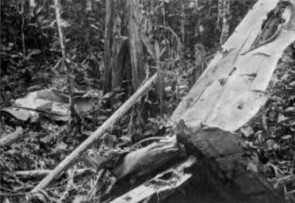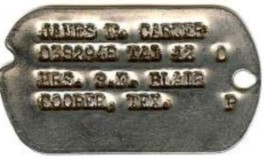
PNGAA Library
Wartime relic—USAF P47 Thunderbolt: Peter Worsley

In early 1963, I was a Patrol Officer based in Lae and carried out patrols both along the coast and also into the Wain and Naba areas in the mountains to the north of Lae. The highest mountain in that area, Mt Bangeta at a little over 13,500 ft, lies on the northern edge of the Naba. At that time Patrol Officers acted as agents for the various war grave commissions, locating the remains of those killed during World War II. The appropriate commission would then be advised. Because of this, during patrols it was standard practice during the evening discussions with the local village people to ask questions regarding the war. It had impacted on some areas much more than others. In 1963 the Naba was a fairly remote and isolated area, quite high up the side of the mountains and seldom visited. Most of the villages had experienced little involvement with the war.
During one patrol I asked the elders of one village if there had been any fighting in or near their village. There hadn’t been, but then someone remembered a plane that had crashed a considerable distance further up the mountain. This jolted the memory of others, and the story was told. A single-engine aircraft had appeared from the north, and having just cleared the mountains had suddenly burst into flames and crashed. I was told that there were no other planes around, and of course there was no anti-aircraft fire in that remote place. I can only presume that it had been damaged by enemy action and, leaking fuel, had caught fire during its endeavours to get back to Port Moresby. They could, of course, give me no idea of a date for the incident.
The people had gone up to the crash site, found the fire had gone out and that the pilot was dead. They left him and the plane and returned to the village. The war between foreigners was no concern of theirs. I asked them if they would take me to the site, and the following day we left early in the morning.
 It took almost the whole day to find the wreck, pushing through the thick bush. Initially all that could be seen were a couple of bits of aluminium scattered among the undergrowth. After clearing some of the trees, more could be seen. It was obvious that on hitting the ground the plane had buried most of its length and over the years the rain had washed dirt in to fill the hole. Sticking up above the ground were the tail and the wing tips, with a scattering of aluminium and windscreen bits lying around.
It took almost the whole day to find the wreck, pushing through the thick bush. Initially all that could be seen were a couple of bits of aluminium scattered among the undergrowth. After clearing some of the trees, more could be seen. It was obvious that on hitting the ground the plane had buried most of its length and over the years the rain had washed dirt in to fill the hole. Sticking up above the ground were the tail and the wing tips, with a scattering of aluminium and windscreen bits lying around.
The remains were of a US Air Force Republic P47 Thunderbolt, a very large American single-engine fighter. The aircraft’s number could just be made out on the tailfin. By this time it was getting late, and there was no time, nor did we have the tools to dig for the remains of the pilot, buried some distance down in the cockpit.
However, lying on the ground half buried in the mud and forest litter was an American dog-tag. This had the name James D. (?) Carter, the numbers 0382948 T41 42, and presumably the next of kin’s name, Mrs S.F. Blair, Cooper, Tex. There were also the letters O and P, probably his blood group and Protestant or Presbyterian. We arrived back at the village after dark, tired, sore and scratched. Time restraints meant that I could not return to the crash the next day, and all I could do was report the matter in my Patrol Report when I arrived back in Lae. I presume that the US War Graves Commission was duly notified, and recovery made of the pilot.
